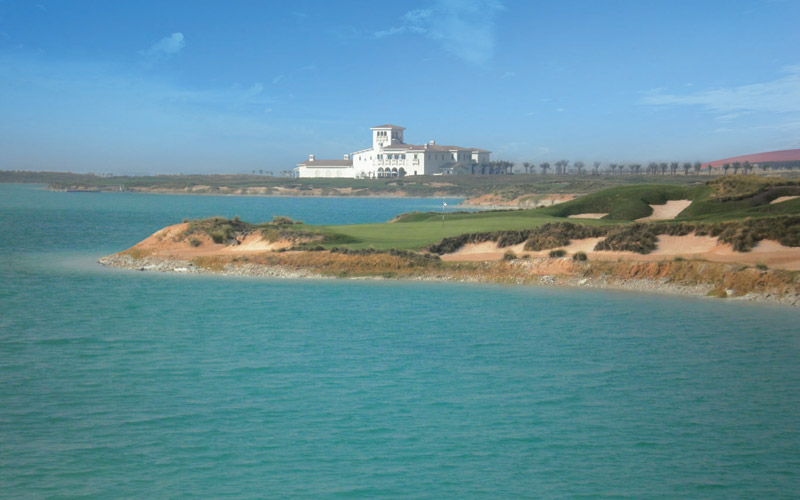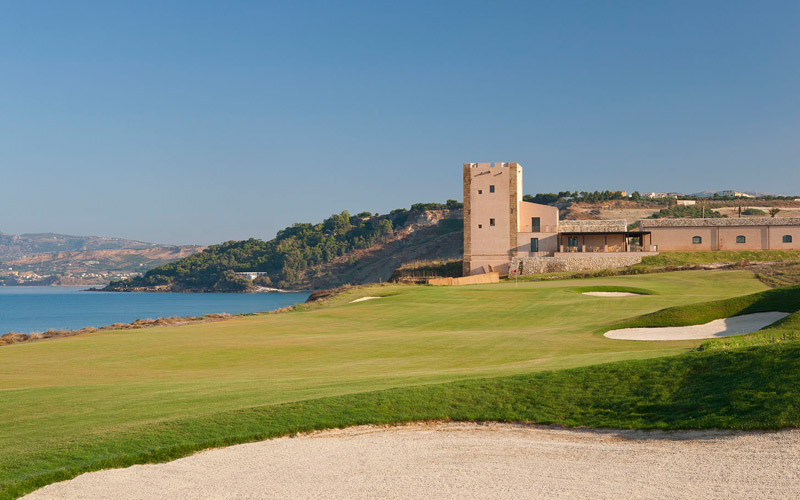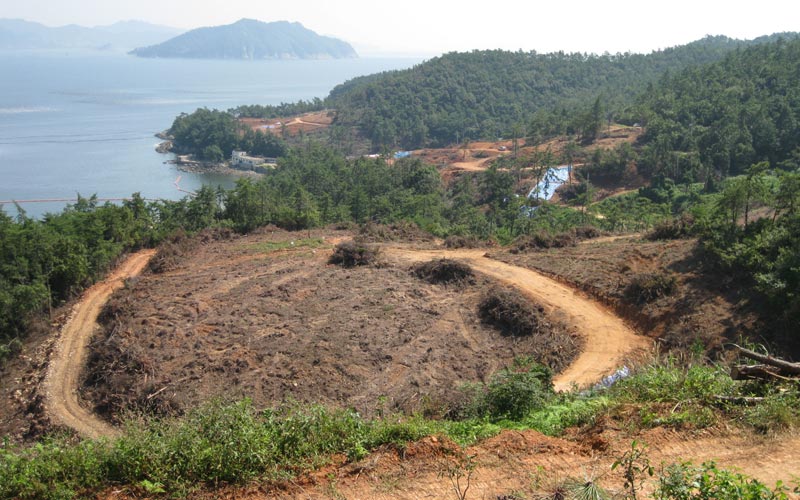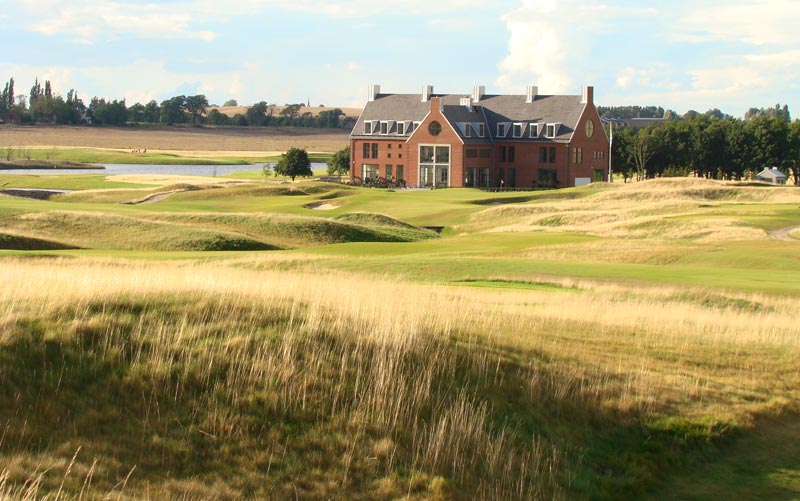Feature Interview with Kyle Phillips
September, 2010

The Middle East’s first great course? The par 3 17th is one of 8 holes that hug the shoreline at Yas Links, Abu Dhabi
1 – Kingsbarns launched your career to the next level with many rave reviews directed particularly at your man-made features. Tell us about the project.
It was one of the very first projects completed after I started my own design company. Kingsbarns was a beautiful coastline, but the site was essentially flat, featureless fields similar to what you see when you arrive on your way to the clubhouse. I had visited the new course at Crail, which was being constructed in a minimalist fashion on a similar type of site. This confirmed my instincts that we needed to create more significant landforms at Kingsbarns.
The opening of Kingsbarns coincided with the 2000 Open Championship played at the Old Course. Being located within the shadows of the R&A meant that it would have the opportunity to be scrutinized by some of the world’s most respected golf connoisseurs and it withstood the test.
2 – Did having early success in Europe make your focus more international, intentionally or not?
I have worked in Europe since the mid 1980’s in the very early part of my career. I enjoy working there, and being exposed to many of the great traditional links and heathland courses has certainly influenced my views of golf course architecture. When I set out on my own in 1997, people knew me in Europe and believed in my abilities enough to give me the opportunity to show what I could do under my own banner.
3 – How has your design style changed since Kingsbarns?
My philosophy is that each course should have its own unique personality and style of architecture. Since Kingsbarns, we have been given the opportunity to create seaside courses at Dundonald, Yas Links, and Verdura. In each of these instances, I have varied the style of the architectural elements in response to the location and “story†of that particular design. Whether an inland or seaside location, I do like to create courses that incorporate traditional architectural elements, such as firm and fast surfaces, hazards that encourage alternative lines of play and tight mowing around green surfaces.
4 -Since Kingsbarns, you have designed courses in Italy, England, Abu Dhabi, etc. What do you currently have in the pipeline?
I am just starting to stick my toe into Asia, specifically China and Korea. We are currently under construction on a new course called “South Cape†along the coast of South Korea. We are also building our second course in Marrakech called “Akenza†and hope to break ground in December on a new course in Holland named “Cromvoirtâ€.A view down the recently cleared 11th, 12th and 13th holes at South Cape, South Korea.
5 – Does your approach to golf course architecture vary depending on the market in which you are working?
I like to design courses that feel as though they belong in their particular landscape. I think it is always important for me to develop a clear vision of the style of architecture with the full understanding and support of my clients in the early stages of the design. I want the owners of my courses to fully understand and embrace each design.
6 – You restored the twelfth hole at Morfontaine in France to play as a true three shotter by moving the green back 80 meters. Of course, that makes the walk to the thirteenth tee farther. When trying to restore playing values, and assuming you can do both (i.e. there is enough room behind the tee and behind the green), how do you decide when to move tees back vs. moving greens back?
The increase in distance you reference was due to moving back both the green and back tees. The walk to the 13th is perhaps 10 meters longer than before. I am always asking ‘how can I make a golf hole better’ which in my mind has no relation to length. It has been refreshing for me to work at Morfontaine, because we have never discussed making the course longer for professionals or for the sake of reaching some number on the scorecard. However, we have discussed how the original landforms that Simpson designed the course around could be restored to their intended purpose for the members. On the 12th, the land allowed the tees to be extended so that drives would go to the top of the hill or just over the top, as Simpson intended. Where previously, with the changes in technology, members had to lay up on the par 5 or else always drive into the heather which bisects the fairway just over the crest of the hill.
7 – We are extremely impressed with your renovation work at the California Golf Club of San Francisco. Tell us how that project took shape in your eyes.
I fought long and hard for a restoration driven renovation versus some of the more ‘drastic’ alternatives that included rerouting the entire course. It is important to keep in mind that only 13 of the original holes were still in place from the Macan and Mackenzie era. The first five holes and the practice range had been rebuilt and compromised in the mid 1960’s when land was lost along the north side of the property and San Bruno Creek was filled in by CalTrans in favor of Westborough Blvd. My objective was to restore as many holes as possible, within the overall goal of putting the best 18 holes on the property. The final result restores 12 of the possible 13 holes and brings back the essence of those lost due to eminent domain in the 60’s. I am thrilled that the new holes, #7 and #8, have won the hearts and minds of the members.

The par 4 11th with the 18th green and clubhouse in the distance. Two ponds that were added in the 90’s have been removed in order to restore Mackenzie’s original bunkering as well as the natural swale that connects these holes.
8 – What aspects of the finished product at The California Club most please you?
What pleases me are members who now say that the new holes on the front nine are better than the back nine. What surprises me are the number of guests who send me unsolicited emails after having just played SF, Olympic and Cal Club during a week outing and proclaim Cal Club their favorite.
9 – Walk us through the creation of the seventh hole at The California Golf Club. Despite some of the great architects that preceded you there, you were the first to both envision the hole and have the ability to build it.
The great old architects distinguished themselves by how well they used the existing landforms. Today we are required to do the same, but also to have the imagination and ability to create “natural†holes on sections of land or even entire sites where the existing condition is not suitable for golf. While I enjoy finding naturally existing holes whenever possible, I am also comfortable to change gears and create natural appearing holes on land that others might not imagine or have the experience to take on. The 7th is a good example of this.
The 7th was a hole that most members could not imagine, so it took some faith on their part. From my perspective the fairway was easy to imagine because there was plenty of width to tie the hole into the surrounds in a way that would allow it to sit naturally. The tricky part was getting the green site exactly right in order to make a nice transition up into the fairway and maintain visibility from all vantage points.
10 – In contrast, your work at Valderrama is a far more gentle approach. How do you approach restoration vs. renovation?
Neither Valderrama nor Morfontaine had the kinds of issues that Cal Club had. These are both ‘trophies’ that simply need to remain polished.
11 – What about Valderrama do you find most compelling?
There are several things. It has been a fun experience to work with the Patinos, Don Jaime and his son Felipe, who are very knowledgeable about the game of golf and have dedicated themselves to Valderrama, making it one of the top clubs in the world. We share a perspective that includes continuing to refine the course to keep up with technology, but in a way that maintains the original design features. Unlike Morfontaine, they have been a regular professional venue and have hosted the Ryder Cup and several Volvo Masters, to name a few. The relationship between the position of the cork oaks and the side slopes of the fairways make for very precise driving. The challenge is to create the right amount of reward to make driver a good option from the tee, but with enough risk that par can be defended against the world’s best on a course that is not considered long by today’s standards.
12 – Please describe your recent work at the Wilshire Country Club in Los Angeles.
Wilshire was designed by Norman Macbeth in 1919. He was an active member and tinkered constantly with his design until his death in 1940. His routing took full advantage of a deep barranca that meandered through the property and comes into play on 16 of the holes. We’ve done a complete Master Plan for the club that restores Macbeth’s design work as much as possible. The most challenging aspect was trying to keep track of all of the changes he made and then determining which features to restore. Shorty after attending the opening of Cypress Point with Mackenzie, Macbeth revised the bunkering at Wilshire from very simple shaped trenches to a much more intricate higher sand flashed style. We completed the first phase of our plan in 2008, which involved restoring almost all of the bunkers and several green expansions. Unfortunately, this phase did not include the restoration of the barranca, much of which has been narrowed and filled in with concrete over the years. Along with the Barranca we hope to someday restore the original 3rd and 18th greens, which both measured over 10,000 s.f. and sat directly on the Barranca’s edge.
13 – Please discuss your approach at Yas Island in Abu Dhabi.
Yas Links is a links course. It is built along the sea, on sand and in every way designed in a links style of architecture. It just happens to be in a warm climate, thus we have planted paspalum grass so that a firm fast playing surface can be retained throughout the year. We were able to significantly enhance and expand the existing shoreline and use the dredged sand to build an interesting variety of dune formations.

An example of the tightly mown rumpled landforms on the par 3 4th that make the ground game so interesting at Yas.
14 – What were the biggest challenges at Verdura, your course for Rocco Forte in Sicily?
Our course was the first new course to be permitted in Sicily, so naturally there was a lack of even very basic golf knowledge on the island. We’ve dealt with this in many countries, but the educational process was particularly challenging in Sicily. I’m very happy with the result though. The development is incredibly green, using over run irrigation water, native plant species in the roughs, low water and low chemical grass types on the fairways, and electric vehicles throughout the development.

The par 4 18th on the West Course at Verdura with the recently restored Tower building that functions as the clubhouse behind. The Mediterranean Sea is visible from all 36 holes at Verdura making this Sicilian resort a top destination in Europe.
15 – When designing a 36-hole complex, would you ever let one course exclusively occupy the better land, thus letting it be obviously superior?
At the PGA of Sweden National, the goal was to create two courses of the highest quality, but very different in terms of architectural style for the sake of variety. The courses are located in different areas of the site, but still share one clubhouse. At Verdura, the two courses share a consistent architectural style and the routings are interwoven so that both courses experience the entire property (Shoreline, Vineyards, Mountain Views, etc.). The routing also allows for a composite course which includes all of the seaside holes.
16 – Tell us about your two courses at the PGA of Sweden National. What kind of site are they on, what kind of grasses did you go with, and what is the playing season?
The site was farmland, both courses have fine fescue rough mixes. The Lakes course has rye grass fairways and tees, with creeping bent on the greens, and the Links course has a traditional blend of bents and fescues throughout the fairways, tees and greens. It is in the south of Sweden, 30 minutes from Copenhagen and not far off the sea, so the season averages 2 months longer than that of Stockholm. This winter has been exceptionally cold almost everywhere, but normally the season would start in late March/early April and end in November, with scattered play through the winter, so it’s a much longer season than Lake Tahoe for example.
17 – While working in Sweden, did you see other courses that impressed you and that you would recommend to seek out?
Halmsted, Falsterbo, and Barseback are all interesting old courses near the sea. Barseback could be the best one, but suffers from too many ‘in house’ alterations. Halmsted really surprised me.
18 – What five courses do you most want to see for the first time?
Old Macdonald, Bandon Trails, both courses at Barnbougle and Hamburger (Falkenstein).
The End











